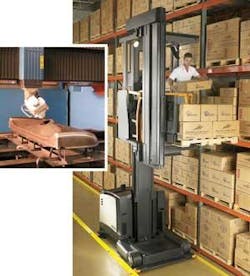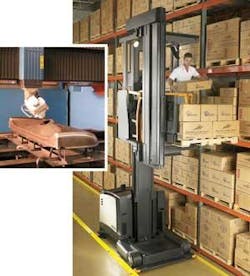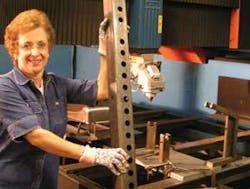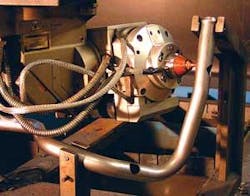Women’s work
Cutting steel with lasers is elementary at this woman-owned job shop
Laureen J. Belleville
To survive and thrive you have to diversify and invest in new technology. That’s been a common thread ILS has heard during many conversations with successful job shops lately. And that’s a lesson hard learned by Renee Smith, current owner of Tigart Laser System Inc. (Indianapolis, IN).
Back in 1982, when Smith’s father-the company’s founder and a retired engineer-needed some office help he turned to his daughter, then a stay-at-home mom who was looking to get back in the outside workforce. Armed with a degree from Purdue University (in English, not engineering), Smith agreed to help out and learned the business from the bottom up. For example, when the company got its first computer she went back to school to learn Unix and wrote a program to set up a database for customer quotes. At that time “the business” comprised a sporting goods/trophy store. When laser engraving of awards became popular, the company invested in a wood laser engraver and became well known for engraving trophies. The name Tigart is derived from her father’s love of tigers combined with the artistry involved with laser engraving.
That first laser purchase became the impetus for future developments. “Once Dad got his name in the laser world,” says Smith, “he started receiving a lot of literature on laser cutters.” And the technology spoke to his roots in manufacturing and engineering-so much so that he sold both the sporting goods store and the trophy business and started a laser steel cutting business. In 1984 the company bought its first laser cutter, a Raskin, and then a second in 1985.
“As the company grew,” explains Smith, “I learned about lasers and manufacturing. I also learned about different steels and how to laser spec steels. At that time, we were the only ones in Indianapolis with a laser.” Which also presented a bit of a challenge. “First I had to learn what it [the laser] did,” remembers Smith. “Then I spent a lot of time explaining it to people because they tended to look at the laser as a ‘Star Wars’ type application. Locally, I had to educate people about what it could do.”
In 1990 the company moved to larger quarters and bought its first five-axis laser-a waterjet cutter that the supplier had tried to adapt to a laser cutter. It failed miserably. Undaunted, the company persevered and, shortly thereafter, purchased a Robomatix five-axis laser with a Coherent 3000W resonator. Unfortunately, this particular system was more appropriately used in assembly line operation, not in a job shop environment. “We struggled with using that machine forever,” recounts Smith. “The processor on it really wasn’t adaptable to continual changing.”
By the mid-1990s, when laser technology was growing in leaps and bounds as far as speed, power, processors, and software, Smith found that she had become a more integral part of the business. Not only had her father been diagnosed with cancer, but also the company was losing business. “We were running two machines two shifts per day and losing business right and left because the technology on these machines had been far surpassed by new equipment. They weren’t able to cut as fast or as well,” she explains. “If we didn’t upgrade our equipment, I knew we might as well give up.”
Not one to bow out without an educated fight, Smith once again set out to do her homework. She estimates that, in conjunction with her shop supervisor and engineer, she spent from six to eight months researching, visiting companies, reading, determining what she wanted and needed, and exploring what various equipment offered. In 1999 she settled on a Bystronic Bystar and almost immediately found that using it she could process the same volume in one shift per day.
Unfortunately, by 2001 the manufacturing recession hit Indiana. “What hit us so hard was that just about every customer we had supplied product to the automotive and trucking industry,” recounts Smith. “We were guilty of not really paying attention to who our customers’ customers were, and that came home to roost in a big way.”
To counter that effect, Smith considered upgrading the Bystronic equipment and embarked on yet another educational journey. During a work/study tour in Switzerland she visited a number of shops that were running both newer and older Bystronic equipment on a 24/7 basis. Shop owners explained that if you maintain the older systems correctly, they will keep working for you-the newer systems were mainly used to address volume. “I came back with a little different perspective because my employees are very good about keeping up with maintenance,” says Smith. “I thought, there’s no reason to replace this machine. If we’re going to do anything, perhaps we need to look to the five-axis, which is outdated.”
With her focus shifted, Smith entered preliminary talks with Prima and was impressed with its Domino system. “The system seemed to do the type of things that we needed. What’s more, we had a very good year in 2004 and were positioned to have a breakout year in 2005,” Smith says. “Then I lost my number-one customer: he decided to buy his own laser. It took a huge chunk of our business.” And the system purchase was put on hold.
As luck would have it, in February of this year, Tigart got an opportunity to cut a large order-thousands and thousands of parts. “We worked for two or three weeks trying to get our Robomatix to cut a preformed tube that needed four holes put into it. Two of the holes were on opposite sides of the tube, which meant you had to be very careful about how you cut them so that the beam did not affect the hole on the opposite side of the tube,” Smith explains. “The Robomatix just was not able to do this.”
Working creatively with Prima, she bought a “gently used” Domino that has been in operation at Tigart since June. The difference, according to Smith, is like night and day. “We cut that whole huge order and will have more of that coming in.” The system can cut flat parts and shaped parts and can perform bevel cutting. It cuts anything from conventional 2D flat sheet work to complex 3D pieces.
Smith is particularly impressed with the capabilities of the Cenit FasTRIM 3D software she purchased for the Domino. “The very sophisticated software is what makes the difference,” Smith points out. “The software lets you rotate the parts and see them on screen and it designs the fixture.”
With its new capabilities new markets have started to open up for Tigart. Previously known primarily as a flat cutter, Smith is also actively soliciting orders for preformed parts and tubes. The company has cut form tubes that go into truck engines, reproduction parts for classic Corvettes, forklifts, engine shrouds, and light covers as well as cutting for companies that provide shelving and fixtures for the fast food industry. “I’m really trying to maintain that diversification because of what happened to us in 2001,” explains Smith. “I also have some customers in the aeronautical industry and, because of our location, we sell to some racecar teams directly and secondarily.” Additionally, the company has been preparing for ISO certification and expects to be certified by early 2006.
Today, Smith is “cautiously optimistic” about the future. Down from a high of 10 in 1999, her current staff of five (plus her 80-year-old mother who still works part time) is adjusting to new equipment and opportunities. “We’ve all had to work a little harder than what we had planned this year,” observes Smith. However, thanks to the additional capabilities with the Prima system, she’s anticipating the need to add a second shift before the end of the year, with the possibility of adding a third shift by June 2006. Says Smith, “For me, it’s been an incredible educational journey. Every day is different.”



